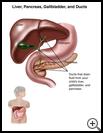
ERCP Exam
________________________________________________________________________
KEY POINTS
- An ERCP exam is a procedure to examine or treat problems in the ducts that drain fluid from your child’s liver, gallbladder, and pancreas.
- It can help remove blockages, take tissue samples, or treat problems such as narrowing, scarring, or infection.
- Ask your provider how long it will take to recover and how to take care of your child at home.
- Make sure you know what symptoms or problems you should watch for and what to do if your child has them.
________________________________________________________________________
What is an ERCP exam?
ERCP (endoscopic retrograde cholangiopancreatography) is a procedure that uses a slim, flexible, lighted tube called an endoscope to examine the ducts that drain fluid from your child’s liver, gallbladder, and pancreas.
The liver makes bile that helps your child’s body break down the fat in food, and ducts carry bile to the gallbladder. The gallbladder is a small sac under the liver on the right side of the body that stores bile. The bile duct carries bile to the small intestine. The pancreas makes fluid that helps break down food. A duct carries digestive fluids from the pancreas to the upper part of the small intestine.
When is it used?
When your child’s healthcare provider has done other tests to diagnose a problem in the gallbladder or bile or pancreas ducts, an ERCP exam may be done to confirm the diagnosis and treat the problem. ERCP may be used to:
- Stretch a narrow area of a duct
- Remove or break up blockages such as stones
- Take tissue samples (biopsy) from a tumor
- Treat problems such as scarring, infection, or inflammation
- Place drainage tubes
How do I prepare my child for this procedure?
- Your child may or may not need to take regular medicines the day of the procedure. Tell the healthcare provider about all medicines and supplements that your child takes. Some products may increase your child’s risk of side effects. Ask the healthcare provider if your child needs to avoid taking any medicine or supplements before the procedure.
- Tell your provider if your child is or may be pregnant.
- The healthcare provider will tell you when your child should stop eating and drinking before the procedure. This helps to keep your child from vomiting during the procedure.
- Tell the provider if your child has had kidney problems or an allergy to chemicals such as contrast dye. Contrast dye is used for some ERCP scans.
- Tell your provider if your child has any food, medicine, or other allergies such as latex.
- Follow any instructions your child’s healthcare provider may give you.
- Ask any questions you have before the procedure. You should understand what the healthcare provider is going to do. You have the right to make decisions about your child’s healthcare and to give permission for any tests or procedures.
What happens during this procedure?
The procedure may be done in an outpatient clinic or hospital.
Your child will be given medicine called anesthesia to keep from feeling pain during the procedure.
- Local anesthesia numbs part of the body where your child will have the procedure. Your child will have a local anesthetic sprayed into the mouth to numb the throat and help prevent gagging.
- General anesthesia relaxes the muscles and puts your child in a deep sleep.
The healthcare provider will insert a tube (scope) into your child’s mouth, down the throat, and through the stomach and small intestine until it reaches the point where the bile duct and pancreatic duct drain into the small intestine. The scope lets the provider see the opening of the duct.
The healthcare provider will inject contrast dye through the scope into the ducts. This makes the ducts show up clearly on X-rays.
Tools are passed through the scope and used to treat problems found during the exam. Tissue samples may be taken for testing in the lab. A small tube may be placed in a duct.
The procedure takes 30 minutes to 2 hours.
What happens after this procedure?
Your child will need to stay at the clinic or hospital for 1 to 2 hours after the procedure. If any kind of treatment is done during ERCP, such as removing a gallstone, your child may need to stay in the hospital overnight.
Follow your healthcare provider's instructions. Ask your healthcare provider:
- How and when you will get your child’s test results
- How long it will take to recover
- If there are activities your child should avoid and when your child can return to normal activities
- How to take care of your child at home
- What symptoms or problems you should watch for and what to do if your child has them
Make sure you know when your child should come back for a checkup. Keep all appointments for provider visits or tests.
What are the risks of this procedure?
Every procedure or treatment has risks. Some possible risks of this procedure include:
- Your child may have problems with anesthesia.
- In rare cases, your child may have an allergic reaction to the contrast dye used during the procedure.
- Your child may have infection or bleeding.
- Other parts of your child’s body may be injured during the procedure.
Ask your healthcare provider how these risks apply to your child. Be sure to discuss any other questions or concerns that you may have.
Last modified: 2017-11-13
Last reviewed: 2017-11-13

